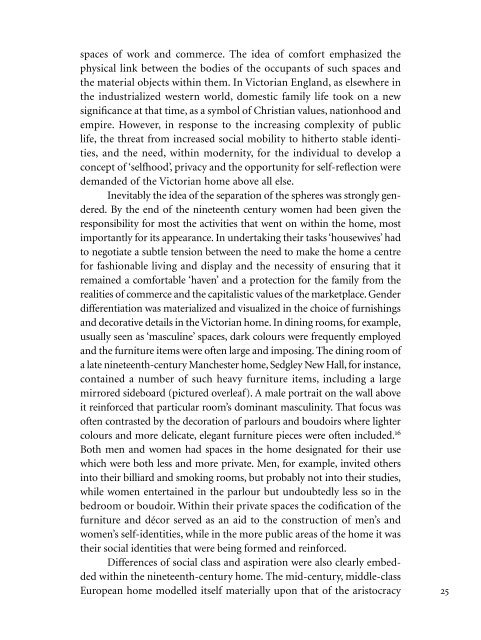Create successful ePaper yourself
Turn your PDF publications into a flip-book with our unique Google optimized e-Paper software.
spaces of work and commerce. <strong>The</strong> idea of comfort emphasized the<br />
physical link between the bodies of the occupants of such spaces and<br />
the material objects within them. In Victorian England, as elsewhere in<br />
the industrialized western world, domestic family life took on a new<br />
significance at that time, as a symbol of Christian values, nationhood and<br />
empire. However, in response to the increasing complexity of public<br />
life, the threat from increased social mobility to hitherto stable identities,<br />
and the need, within modernity, for the individual to develop a<br />
concept of ‘selfhood’, privacy and the opportunity for self-reflection were<br />
demanded of the Victorian home above all else.<br />
Inevitably the idea of the separation of the spheres was strongly gendered.<br />
By the end of the nineteenth century women had been given the<br />
responsibility for most the activities that went on within the home, most<br />
importantly for its appearance. In undertaking their tasks ‘housewives’ had<br />
to negotiate a subtle tension between the need to make the home a centre<br />
for fashionable living and display and the necessity of ensuring that it<br />
remained a comfortable ‘haven’ and a protection for the family from the<br />
realities of commerce and the capitalistic values of the marketplace. Gender<br />
differentiation was materialized and visualized in the choice of furnishings<br />
and decorative details in the Victorian home. In dining rooms, for example,<br />
usually seen as ‘masculine’ spaces, dark colours were frequently employed<br />
and the furniture items were often large and imposing. <strong>The</strong> dining room of<br />
a late nineteenth-century Manchester home, Sedgley New Hall, for instance,<br />
contained a number of such heavy furniture items, including a large<br />
mirrored sideboard (pictured overleaf). A male portrait on the wall above<br />
it reinforced that particular room’s dominant masculinity. That focus was<br />
often contrasted by the decoration of parlours and boudoirs where lighter<br />
colours and more delicate, elegant furniture pieces were often included. 16<br />
Both men and women had spaces in the home designated for their use<br />
which were both less and more private. Men, for example, invited others<br />
into their billiard and smoking rooms, but probably not into their studies,<br />
while women entertained in the parlour but undoubtedly less so in the<br />
bedroom or boudoir. Within their private spaces the codification of the<br />
furniture and décor served as an aid to the construction of men’s and<br />
women’s self-identities, while in the more public areas of the home it was<br />
their social identities that were being formed and reinforced.<br />
Differences of social class and aspiration were also clearly embedded<br />
within the nineteenth-century home. <strong>The</strong> mid-century, middle-class<br />
European home modelled itself materially upon that of the aristocracy 25



